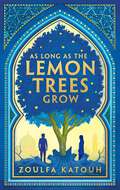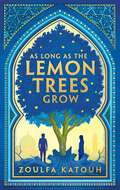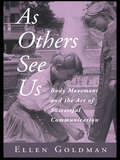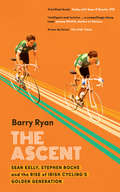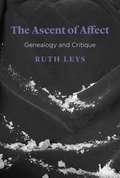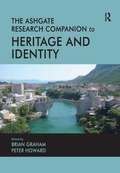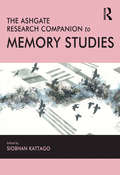- Table View
- List View
AS-Level Psychology for AQA A: Complete Revision and Practice (PDF)
by Coordination Group PublicationsWritten for the AQA A AS-Level course, this book covers the AQA A course - providing the facts students need to know to get an A grade with questions for students to check their progress and understanding. It also covers the 'How Science Works' part of the course, with evaluation of the key experiments.
AS Level Psychology Workbook
by Clare CharlesAS Level Psychology Workbook includes structured worksheets for students to fill in as they progress through their AS psychology course. The resulting notes are aimed to provide a useful resource bank for revision purposes. In addition to outlining a structure for note-taking, the workbook also gives supported guidance on everything students need to know in order to do well in the exams. The content is directly relevant to the AQA Specification A and can be used in conjunction with any AS psychology textbook. To integrate with the rest of the learning materials in the Psychology Press A-Level Programme, cross-references are provided throughout to the appropriate pages in Eysenck’s AS Level Psychology, and Brody and Dwyer’s Revise AS Level Psychology. AS Level Psychology Workbook includes the following features: Learning objectives that condense the vast amount of specification content into focused and manageable chunks for each topic Structured worksheets that map on to each of the learning objectives and consist of cues for note-taking, opportunities to fill in the blanks, and activities to enrich learning “Using this in the exam” sections that consider possible exam questions, along with guidance on how to answer them. This workbook will be invaluable for all students tackling AS psychology. It enables them to navigate through the wealth of material linked to the subject, and encourages active learning to promote enjoyment of study. The AS workbook has been fully revised for the new specification for teaching from September 2008.
AS Level Psychology Workbook
by Clare CharlesAS Level Psychology Workbook includes structured worksheets for students to fill in as they progress through their AS psychology course. The resulting notes are aimed to provide a useful resource bank for revision purposes. In addition to outlining a structure for note-taking, the workbook also gives supported guidance on everything students need to know in order to do well in the exams. The content is directly relevant to the AQA Specification A and can be used in conjunction with any AS psychology textbook. To integrate with the rest of the learning materials in the Psychology Press A-Level Programme, cross-references are provided throughout to the appropriate pages in Eysenck’s AS Level Psychology, and Brody and Dwyer’s Revise AS Level Psychology. AS Level Psychology Workbook includes the following features: Learning objectives that condense the vast amount of specification content into focused and manageable chunks for each topic Structured worksheets that map on to each of the learning objectives and consist of cues for note-taking, opportunities to fill in the blanks, and activities to enrich learning “Using this in the exam” sections that consider possible exam questions, along with guidance on how to answer them. This workbook will be invaluable for all students tackling AS psychology. It enables them to navigate through the wealth of material linked to the subject, and encourages active learning to promote enjoyment of study. The AS workbook has been fully revised for the new specification for teaching from September 2008.
As Long As the Lemon Trees Grow
by Zoulfa KatouhBurning with the fires of hope and possibility, AS LONG AS THE LEMON TREES GROW will sweep you up and never let you go.Salama Kassab was a pharmacy student when the cries for freedom broke out in Syria. She still had her parents and her big brother; she still had her home. She was even supposed to be meeting a boy to talk about marriage. Now Salama volunteers at a hospital in Homs, helping the wounded who flood through the doors. She knows that she should be thinking about leaving, but who will help the people of her beloved country if she doesn't? With her heart so conflicted, her mind has conjured a vision to spur her to action. His name is Khawf, and he haunts her nights with hallucinations of everything she has lost.But even with Khawf pressing her to leave, when she crosses paths with Kenan, the boy she was supposed to meet on that fateful day, she starts to doubt her resolve in leaving home at all. Soon, Salama must learn to see the events around her for what they truly are-not a war, but a revolution-and decide how she, too, will cry for Syria's freedom.
As Long As the Lemon Trees Grow
by Zoulfa KatouhBurning with the fires of hope and possibility, AS LONG AS THE LEMON TREES GROW will sweep you up and never let you go.Salama Kassab was a pharmacy student when the cries for freedom broke out in Syria. She still had her parents and her big brother; she still had her home. She was even supposed to be meeting a boy to talk about marriage. Now Salama volunteers at a hospital in Homs, helping the wounded who flood through the doors. She knows that she should be thinking about leaving, but who will help the people of her beloved country if she doesn't? With her heart so conflicted, her mind has conjured a vision to spur her to action. His name is Khawf, and he haunts her nights with hallucinations of everything she has lost.But even with Khawf pressing her to leave, when she crosses paths with Kenan, the boy she was supposed to meet on that fateful day, she starts to doubt her resolve in leaving home at all. Soon, Salama must learn to see the events around her for what they truly are-not a war, but a revolution-and decide how she, too, will cry for Syria's freedom.
As Others See Us: Body Movement and the Art of Successful Communication
by Ellen GoldmanAs Others See Us, first published in 1994 by Gordon & Breach, is a book designed to introduce the reader to a new way of thinking about the movements, both conscious and unconscious, that we make every day and every second of our lives. Goldman describes the human experience as a continuous stream of body movements, though we are only aware of a small fraction of the more obvious and intrusive physical acts. The aim of this book is first to increase awareness of the subtleties and complexities of our body language, and then to encourage the reader to perceive these intricacies in their own movements and in those of others. Finally, with a more complete understanding and appreciation for the power of body language and non-verbal communication, one can achieve a deeper connection between physical and intellectual spheres, to allow for a fuller and more engaging experience of communication and expression. This new knowledge of the human body's movements not only permits one to more accurately perceive the emotions and thoughts of others, but can allow a glimpse into one's own mind, to see how we present ourselves to the world, and whether our thoughts are in sync with our actions. Central to the text is the author's treatment of the Integrated Movement, a term used to describe the merger of a posture and a gesture with a consistent quality, dynamic or shape. This approach to understanding and explaining human movement offers a unique way of thinking about conscious gesture, unconscious body language, and verbal speech as interconnected communication, a synthesis that allows for a more complete view of ourselves and others around us. The structure of the book follows a logical framework that mirrors the progress of the reader, from perception of movement, to the close inspection of gesture and body language, to the introduction and experience of Integrated Movement, to the application of one's new awareness to different aspects of life. Biographical sketches of leading figures in the field are included, as are suggestions for additional reading and resources. Perhaps the most unique feature of the book are the personal exercises (boxed-off text) that appear on almost every other page. These exercises are designed to allow the reader to experience the power of body language in real-life situations, while working towards the increased awareness and perception that is the goal of the book.
As Others See Us: Body Movement and the Art of Successful Communication
by Ellen GoldmanAs Others See Us, first published in 1994 by Gordon & Breach, is a book designed to introduce the reader to a new way of thinking about the movements, both conscious and unconscious, that we make every day and every second of our lives. Goldman describes the human experience as a continuous stream of body movements, though we are only aware of a small fraction of the more obvious and intrusive physical acts. The aim of this book is first to increase awareness of the subtleties and complexities of our body language, and then to encourage the reader to perceive these intricacies in their own movements and in those of others. Finally, with a more complete understanding and appreciation for the power of body language and non-verbal communication, one can achieve a deeper connection between physical and intellectual spheres, to allow for a fuller and more engaging experience of communication and expression. This new knowledge of the human body's movements not only permits one to more accurately perceive the emotions and thoughts of others, but can allow a glimpse into one's own mind, to see how we present ourselves to the world, and whether our thoughts are in sync with our actions. Central to the text is the author's treatment of the Integrated Movement, a term used to describe the merger of a posture and a gesture with a consistent quality, dynamic or shape. This approach to understanding and explaining human movement offers a unique way of thinking about conscious gesture, unconscious body language, and verbal speech as interconnected communication, a synthesis that allows for a more complete view of ourselves and others around us. The structure of the book follows a logical framework that mirrors the progress of the reader, from perception of movement, to the close inspection of gesture and body language, to the introduction and experience of Integrated Movement, to the application of one's new awareness to different aspects of life. Biographical sketches of leading figures in the field are included, as are suggestions for additional reading and resources. Perhaps the most unique feature of the book are the personal exercises (boxed-off text) that appear on almost every other page. These exercises are designed to allow the reader to experience the power of body language in real-life situations, while working towards the increased awareness and perception that is the goal of the book.
The Ascent: Sean Kelly, Stephen Roche and the Rise of Irish Cycling’s Golden Generation
by Barry RyanBarry Ryan is European Editor at Cyclingnews. He has covered professional cycling since 2010, reporting from the Tour de France, Giro d’Italia and other events from Argentina to Japan. His writing has appeared in The Independent, Procycling and Cycling Plus. He is from Glanworth in County Cork.
The Ascent of Affect: Genealogy and Critique
by Ruth LeysIn recent years, emotions have become a major, vibrant topic of research not merely in the biological and psychological sciences but throughout a wide swath of the humanities and social sciences as well. Yet, surprisingly, there is still no consensus on their basic nature or workings. Ruth Leys’s brilliant, much anticipated history, therefore, is a story of controversy and disagreement. The Ascent of Affect focuses on the post–World War II period, when interest in emotions as an object of study began to revive. Leys analyzes the ongoing debate over how to understand emotions, paying particular attention to the continual conflict between camps that argue for the intentionality or meaning of emotions but have trouble explaining their presence in non-human animals and those that argue for the universality of emotions but struggle when the question turns to meaning. Addressing the work of key figures from across the spectrum, considering the potentially misleading appeal of neuroscience for those working in the humanities, and bringing her story fully up to date by taking in the latest debates, Leys presents here the most thorough analysis available of how we have tried to think about how we feel.
The Ascent of Affect: Genealogy and Critique
by Ruth LeysIn recent years, emotions have become a major, vibrant topic of research not merely in the biological and psychological sciences but throughout a wide swath of the humanities and social sciences as well. Yet, surprisingly, there is still no consensus on their basic nature or workings. Ruth Leys’s brilliant, much anticipated history, therefore, is a story of controversy and disagreement. The Ascent of Affect focuses on the post–World War II period, when interest in emotions as an object of study began to revive. Leys analyzes the ongoing debate over how to understand emotions, paying particular attention to the continual conflict between camps that argue for the intentionality or meaning of emotions but have trouble explaining their presence in non-human animals and those that argue for the universality of emotions but struggle when the question turns to meaning. Addressing the work of key figures from across the spectrum, considering the potentially misleading appeal of neuroscience for those working in the humanities, and bringing her story fully up to date by taking in the latest debates, Leys presents here the most thorough analysis available of how we have tried to think about how we feel.
The Ascent of Affect: Genealogy and Critique
by Ruth LeysIn recent years, emotions have become a major, vibrant topic of research not merely in the biological and psychological sciences but throughout a wide swath of the humanities and social sciences as well. Yet, surprisingly, there is still no consensus on their basic nature or workings. Ruth Leys’s brilliant, much anticipated history, therefore, is a story of controversy and disagreement. The Ascent of Affect focuses on the post–World War II period, when interest in emotions as an object of study began to revive. Leys analyzes the ongoing debate over how to understand emotions, paying particular attention to the continual conflict between camps that argue for the intentionality or meaning of emotions but have trouble explaining their presence in non-human animals and those that argue for the universality of emotions but struggle when the question turns to meaning. Addressing the work of key figures from across the spectrum, considering the potentially misleading appeal of neuroscience for those working in the humanities, and bringing her story fully up to date by taking in the latest debates, Leys presents here the most thorough analysis available of how we have tried to think about how we feel.
The Ascent of Affect: Genealogy and Critique
by Ruth LeysIn recent years, emotions have become a major, vibrant topic of research not merely in the biological and psychological sciences but throughout a wide swath of the humanities and social sciences as well. Yet, surprisingly, there is still no consensus on their basic nature or workings. Ruth Leys’s brilliant, much anticipated history, therefore, is a story of controversy and disagreement. The Ascent of Affect focuses on the post–World War II period, when interest in emotions as an object of study began to revive. Leys analyzes the ongoing debate over how to understand emotions, paying particular attention to the continual conflict between camps that argue for the intentionality or meaning of emotions but have trouble explaining their presence in non-human animals and those that argue for the universality of emotions but struggle when the question turns to meaning. Addressing the work of key figures from across the spectrum, considering the potentially misleading appeal of neuroscience for those working in the humanities, and bringing her story fully up to date by taking in the latest debates, Leys presents here the most thorough analysis available of how we have tried to think about how we feel.
The Ascent of Affect: Genealogy and Critique
by Ruth LeysIn recent years, emotions have become a major, vibrant topic of research not merely in the biological and psychological sciences but throughout a wide swath of the humanities and social sciences as well. Yet, surprisingly, there is still no consensus on their basic nature or workings. Ruth Leys’s brilliant, much anticipated history, therefore, is a story of controversy and disagreement. The Ascent of Affect focuses on the post–World War II period, when interest in emotions as an object of study began to revive. Leys analyzes the ongoing debate over how to understand emotions, paying particular attention to the continual conflict between camps that argue for the intentionality or meaning of emotions but have trouble explaining their presence in non-human animals and those that argue for the universality of emotions but struggle when the question turns to meaning. Addressing the work of key figures from across the spectrum, considering the potentially misleading appeal of neuroscience for those working in the humanities, and bringing her story fully up to date by taking in the latest debates, Leys presents here the most thorough analysis available of how we have tried to think about how we feel.
The Ascent of Affect: Genealogy and Critique
by Ruth LeysIn recent years, emotions have become a major, vibrant topic of research not merely in the biological and psychological sciences but throughout a wide swath of the humanities and social sciences as well. Yet, surprisingly, there is still no consensus on their basic nature or workings. Ruth Leys’s brilliant, much anticipated history, therefore, is a story of controversy and disagreement. The Ascent of Affect focuses on the post–World War II period, when interest in emotions as an object of study began to revive. Leys analyzes the ongoing debate over how to understand emotions, paying particular attention to the continual conflict between camps that argue for the intentionality or meaning of emotions but have trouble explaining their presence in non-human animals and those that argue for the universality of emotions but struggle when the question turns to meaning. Addressing the work of key figures from across the spectrum, considering the potentially misleading appeal of neuroscience for those working in the humanities, and bringing her story fully up to date by taking in the latest debates, Leys presents here the most thorough analysis available of how we have tried to think about how we feel.
The ASD Feel Better Book: A Visual Guide to Help Brain and Body for Children on the Autism Spectrum (PDF)
by Joel ShaulThe ASD Feel Better Book is designed to help children on the autism spectrum develop insight into what can upset them and make them feel bad and then increase their awareness of how to make themselves feel good again. With visual maps and icons, the book proceeds through various components of the body and mind to isolate many of the things that can go wrong and explores how children can try to set them right. Designed to be read with an adult, there are problem-solving exercises and skills practice in the form of activities, games and worksheets.
The ASD Workbook: Understanding Your Autism Spectrum Disorder (PDF)
by Penny KershawA diagnosis of an Autism Spectrum Disorder (ASD) can be confusing and overwhelming for all involved, and it can be difficult for parents to know how best to approach the subject with their child. This easy-to-use interactive workbook gives parents the help they need to explain ASDs to their child and provide practical and emotional support following diagnosis. Parents are invited to work through each chapter with their child as they grow older and go through adolescence, encouraging them to talk through how the ASD affects each area of their life, from making friends to problem-solving to planning a career. The information and advice is presented in a clear and positive way to help both parent and child understand more about what the diagnosis means for them. As the workbook is completed an invaluable record of development will be created for parent and child to look back on together. This hands-on workbook is an essential resource for parents and carers looking for guidance on explaining ASDs from diagnosis onwards to children aged 10 and up.
Asexualities: Feminist and Queer Perspectives (Routledge Research in Gender and Society)
by Karli June Cerankowski Megan MilksWhat is so radical about not having sex? To answer this question, this collection of essays explores the feminist and queer politics of asexuality. Asexuality is predominantly understood as an orientation describing people who do not experience sexual attraction. In this multidisciplinary volume, the authors expand this definition of asexuality to account for the complexities of gender, race, disability, and medical discourse. Together, these essays challenge the ways in which we imagine gender and sexuality in relation to desire and sexual practice. Asexualities provides a critical reevaluation of even the most radical queer theorizations of sexuality. Going beyond a call for acceptance of asexuality as a legitimate and valid sexual orientation, the authors offer a critical examination of many of the most fundamental ways in which we categorize and index sexualities, desires, bodies, and practices. As the first book-length collection of critical essays ever produced on the topic of asexuality, this book serves as a foundational text in a growing field of study. It also aims to reshape the directions of feminist and queer studies, and to radically alter popular conceptions of sex and desire. Including units addressing theories of asexual orientation; the politics of asexuality; asexuality in media culture; masculinity and asexuality; health, disability, and medicalization; and asexual literary theory, Asexualities will be of interest to scholars and students in sexuality, gender, sociology, cultural studies, disability studies, and media culture.
Asexualities: Feminist and Queer Perspectives (Routledge Research in Gender and Society #40)
by Karli June Cerankowski Megan MilksWhat is so radical about not having sex? To answer this question, this collection of essays explores the feminist and queer politics of asexuality. Asexuality is predominantly understood as an orientation describing people who do not experience sexual attraction. In this multidisciplinary volume, the authors expand this definition of asexuality to account for the complexities of gender, race, disability, and medical discourse. Together, these essays challenge the ways in which we imagine gender and sexuality in relation to desire and sexual practice. Asexualities provides a critical reevaluation of even the most radical queer theorizations of sexuality. Going beyond a call for acceptance of asexuality as a legitimate and valid sexual orientation, the authors offer a critical examination of many of the most fundamental ways in which we categorize and index sexualities, desires, bodies, and practices. As the first book-length collection of critical essays ever produced on the topic of asexuality, this book serves as a foundational text in a growing field of study. It also aims to reshape the directions of feminist and queer studies, and to radically alter popular conceptions of sex and desire. Including units addressing theories of asexual orientation; the politics of asexuality; asexuality in media culture; masculinity and asexuality; health, disability, and medicalization; and asexual literary theory, Asexualities will be of interest to scholars and students in sexuality, gender, sociology, cultural studies, disability studies, and media culture.
Asexuality and Freudian-Lacanian Psychoanalysis: Towards a Theory of an Enigma
by Kevin MurphyAsexuality and Freudian-Lacanian Psychoanalysis: Towards a Theory of an Enigma proposes that asexuality is a libidinally founded desire for no sexual desire, a concept not included in psychoanalytic theory up to now. "Asexuality" is defined as the experience of having no sexual attraction for another person; as an emerging self-defined sexual orientation, it has received practically no attention from psychoanalytic research. This book is the first sustained piece of exploratory and theoretical research from a Freudian-Lacanian perspective. Using Freudian concepts to understand the intricacies of human sexual desire, this volume will also employ Lacanian conceptual tools to understand how asexuality might sustain itself despite the absence of Other-directed sexual desire. This book argues that asexuality holds a mirror to contemporary sexualized society which assumes sexual attraction and eroticism as the benchmarks for experiencing sexual desire. It also argues that asexuality may be a previously unrecognized form of human sexuality which can contribute new understandings to the range and breadth of what it means to be a sexual being. This book will be of interest to anyone in the area of asexuality or sexuality – psychoanalysts, psychotherapists, psychologists, psychiatrists, university lecturers, researchers, students or those simply curious about the possibilities of the human sex drive.
Asexuality and Freudian-Lacanian Psychoanalysis: Towards a Theory of an Enigma
by Kevin MurphyAsexuality and Freudian-Lacanian Psychoanalysis: Towards a Theory of an Enigma proposes that asexuality is a libidinally founded desire for no sexual desire, a concept not included in psychoanalytic theory up to now. "Asexuality" is defined as the experience of having no sexual attraction for another person; as an emerging self-defined sexual orientation, it has received practically no attention from psychoanalytic research. This book is the first sustained piece of exploratory and theoretical research from a Freudian-Lacanian perspective. Using Freudian concepts to understand the intricacies of human sexual desire, this volume will also employ Lacanian conceptual tools to understand how asexuality might sustain itself despite the absence of Other-directed sexual desire. This book argues that asexuality holds a mirror to contemporary sexualized society which assumes sexual attraction and eroticism as the benchmarks for experiencing sexual desire. It also argues that asexuality may be a previously unrecognized form of human sexuality which can contribute new understandings to the range and breadth of what it means to be a sexual being. This book will be of interest to anyone in the area of asexuality or sexuality – psychoanalysts, psychotherapists, psychologists, psychiatrists, university lecturers, researchers, students or those simply curious about the possibilities of the human sex drive.
The Ashgate Research Companion To Heritage And Identity (PDF)
by Brian Graham Peter HowardHeritage represents the meanings and representations conveyed in the present day upon artifacts, landscapes, mythologies, memories and traditions from the past. It is a key element in the shaping of identities, particularly in the context of increasingly multicultural societies. This Research Companion brings together an international team of authors to discuss the concepts, ideas and practices that inform the entwining of heritage and identity. They have assembled a wide geographical range of examples and interpret them through a number of disciplinary lenses that include geography, history, museum and heritage studies, archaeology, art history, history, anthropology and media studies. This outstanding companion offers scholars and graduate students a thoroughly up-to-date guide to current thinking and a comprehensive reference to this growing field.
The Ashgate Research Companion to Memory Studies
by Siobhan KattagoMemory has long been a subject of fascination for poets, artists, philosophers and historians. This timely volume, edited by Siobhan Kattago, examines how past events are remembered, contested, forgotten, learned from and shared with others. Each author in The Ashgate Research Companion to Memory Studies has been asked to reflect on his or her research companions as a scholar, who studies memory. The original studies presented in the volume are written by leading experts, who emphasize both the continuity of heritage and tradition, as well as the memory of hostilities, traumas and painful events. Comprised of four thematic sections, The Ashgate Research Companion to Memory Studies provides a comprehensive overview of the latest research within the discipline. The principal themes include: ¢ Memory, History and Time ¢ Social, Psychological and Cultural Frameworks of Memory ¢ Acts and Places of Memory ¢ Politics of Memory, Forgetting and Democracy Featuring contributions from key thinkers in the field, this comprehensive volume will be a valuable resource for all academics and students working within this area of study.
The Ashgate Research Companion to Memory Studies
by Siobhan KattagoMemory has long been a subject of fascination for poets, artists, philosophers and historians. This timely volume, edited by Siobhan Kattago, examines how past events are remembered, contested, forgotten, learned from and shared with others. Each author in The Ashgate Research Companion to Memory Studies has been asked to reflect on his or her research companions as a scholar, who studies memory. The original studies presented in the volume are written by leading experts, who emphasize both the continuity of heritage and tradition, as well as the memory of hostilities, traumas and painful events. Comprised of four thematic sections, The Ashgate Research Companion to Memory Studies provides a comprehensive overview of the latest research within the discipline. The principal themes include: ¢ Memory, History and Time ¢ Social, Psychological and Cultural Frameworks of Memory ¢ Acts and Places of Memory ¢ Politics of Memory, Forgetting and Democracy Featuring contributions from key thinkers in the field, this comprehensive volume will be a valuable resource for all academics and students working within this area of study.
Asia-Pacific Perspectives on Intercultural Psychology
by Darrin Hodgetts Wendy Wen Li Koong Hean FooToday‘s world is more interconnected and interdependent than ever before. Within the context of globalisation and the associated increased contact between diverse groups of people, the psychology of culture is more relevant than ever. Asia-Pacific Perspectives on Intercultural Psychology brings together leading researchers from 11 countries to show
Asia-Pacific Perspectives on Intercultural Psychology
by Darrin Hodgetts Wendy Wen Li Koong Hean FooToday�s world is more interconnected and interdependent than ever before. Within the context of globalisation and the associated increased contact between diverse groups of people, the psychology of culture is more relevant than ever. Asia-Pacific Perspectives on Intercultural Psychology brings together leading researchers from 11 countries to show


